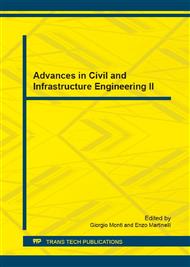p.479
p.485
p.492
p.505
p.513
p.521
p.529
p.537
p.544
Steel to Concrete Bond Transferring in CFST Columns Connected to Beams through the Concrete
Abstract:
An important innovation in structural design in the last thirty years has been the use of steel-concrete composite columns, with particular diffusion of tubular profiles. These elements are known in the technical Literature as concrete filled steel tube (CFST) and the metal profiles that characterize the external jacket are usually circular, square or rectangular.A relevant issue that must be considered is the transfer of shear stresses by adhesion between steel and concrete in composite columns. The problem of adhesion, and thus its formulation, depends primarily on the type of technology used to connect beams to columns. In particular, two different models can be produced: the first case where the beams are connected only to the metal external jacket of the pillar (i.e. steel beams connected with bolted flanges to the column), and the second where beams and columns are connected also in the concrete matrix (i.e. the case of beams in steel-concrete technology, or traditional reinforced concrete beams).International Standards, regarding the problem of adhesion in jacketed columns, only referee to the first connection type, giving a constant value for adhesion coefficient along the transferring length, with no dependence to the size of the section, and indicate transferring lengths independently from the type of beam-to-column connection and the shape of the section. In the Paper are hence proposed expressions that quantify the fundamental values that govern the action transfer mechanism by adhesion in CFST, such as the transfer length, the perimeter of the active transfer and the shear stress distribution, as a function of the slenderness ratio and of the type of connection adopted. All this has been carried in order to produce a model for the estimation of bond stresses for the second of the two construction system mentioned above.
Info:
Periodical:
Pages:
513-520
Citation:
Online since:
July 2016
Authors:
Price:
Сopyright:
© 2016 Trans Tech Publications Ltd. All Rights Reserved
Share:
Citation:


